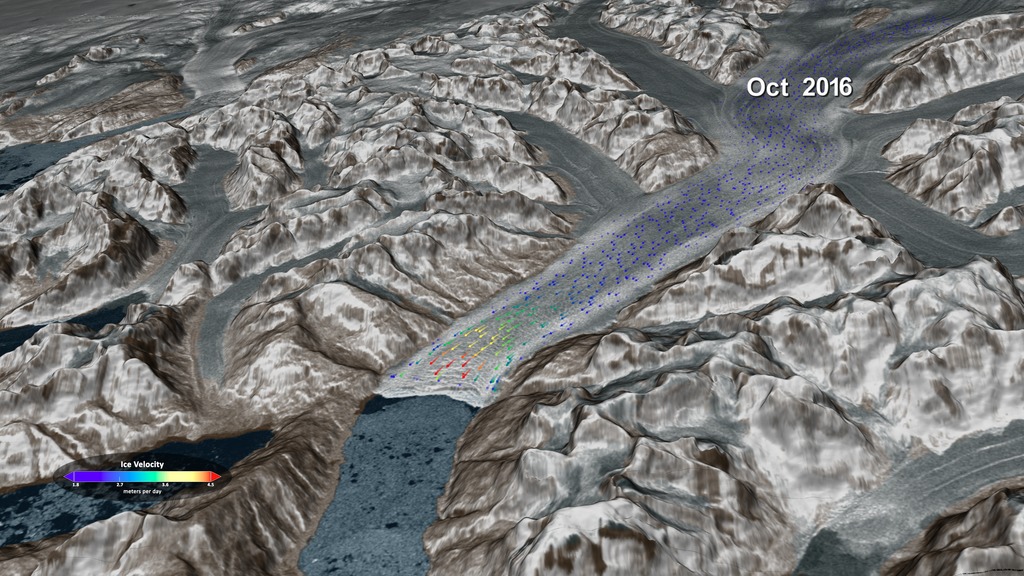At Glacial Speed

A NASA satellite tracks glaciers' slow but steady journey to the sea.
Glaciers and ice sheets move in unique and sometimes surprising patterns, as evidenced by a new capability that uses satellite images to map the speed of flowing ice in Greenland, Antarctica and mountain ranges around the world. With imagery and data from Landsat 8, a joint mission of NASA and the U.S. Geological Survey, scientists are providing a near-real-time view of every large glacier and ice sheet on Earth. Researchers aim to better understand how ice flow is changing worldwide by integrating information about atmosphere and ocean conditions to determine what causes these ice sheets to change – and what that means for how much ice is flowing into the ocean. That could help provide critical information to coastal communities that will be most impacted by sea level rise. The Heimdal glacier in Southeast Greenland shown here can travel more than 33 feet (10 meters) per day in early summer and less than 20 feet (6 meters) per day by October. Watch the video to learn more.
Explore how scientists determine glacial speed from space.
Glaciers may move faster or slower depending on the season, as seen in this visualization of Heimdal Glacier in Greenland.

Landsat 8 imagery taken 16 days apart uses changes in the texture of the Heimdal glacier's surface to determine its speed.
For More Information
See NASA.gov
Credits
Please give credit for this item to:
NASA's Scientific Visualization Studio.
Photo of Heimdal glacier courtesy of NASA/John Sonntag.
-
Writer
- Kate Ramsayer (Telophase)
-
Animators
- Cindy Starr (Global Science and Technology, Inc.)
- Horace Mitchell (NASA/GSFC)
- Greg Shirah (NASA/GSFC)
-
Producers
- Matthew R. Radcliff (USRA)
- Kathryn Mersmann (USRA)
-
Scientists
- Twila Moon (University of Bristol)
- Mark Fahnestock (University of Alaska)
- Ted Scambos (NSIDC)
- Alex S. Gardner (NASA/JPL CalTech)
-
Project support
- Joycelyn Thomson Jones (NASA/GSFC)
- Eric Sokolowsky (Global Science and Technology, Inc.)
- Leann Johnson (Global Science and Technology, Inc.)
-
Technical support
- Laurence Schuler (ADNET Systems, Inc.)
- Ian Jones (ADNET Systems, Inc.)
Release date
This page was originally published on Monday, March 13, 2017.
This page was last updated on Wednesday, May 3, 2023 at 1:47 PM EDT.
Missions
This page is related to the following missions:Datasets used
-
[RADARSAT-1: SAR]
ID: 87Credit: Additional credit goes to Canadian Space Agency, RADARSAT International Inc.
See all pages that use this dataset -
GIMP Greenland DEM (Greenland Mapping Project (GIMP) Digital Elevation Model)
ID: 746 -
GoLIVE (Global Land Ice Velocity) [Landsat-8]
ID: 964Credit: Mark Fahnstock (Univ. of Alaska), Twila Moon (Univ. of Bristol), Ted Scambos (Univ. of Colorado/NSIDC), Marin Klinger (Univ. of Colorado/NSIDC), Alex Gardner (JPL), Terry Haran (Univ. of Colorado/NSIDC)
See all pages that use this dataset
Note: While we identify the data sets used on this page, we do not store any further details, nor the data sets themselves on our site.
![Heimdal Glacier in southeastern Greenland shows a regular speed up and slow down with the seasons. Peak speeds are around May/June, and low speeds occur in September/October. This velocity data is a result of new analysis of imagery from the Operational Land Imager on the NASA/USGS Landsat 8 satellite, part of the Global Landsat Ice Velocity Extraction (GoLIVE) project.Music credit: Tiny Worlds by Christian Telford [ASCAP], David Travis Edwards [ASCAP], Matthew St Laurent [ASCAP], Robert Anthony Navarro [ASCAP]Complete transcript available.Watch this video on the NASA Goddard YouTube channel.](/vis/a010000/a012400/a012444/LARGE_MP4-12444_icevelocity_fix_large.00155_print.jpg)
